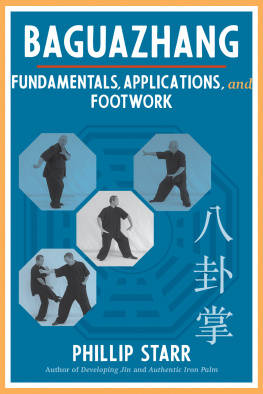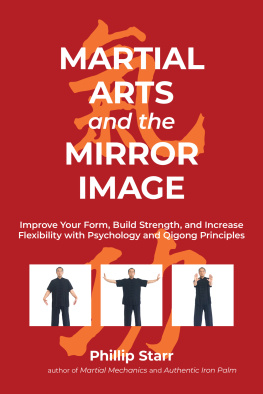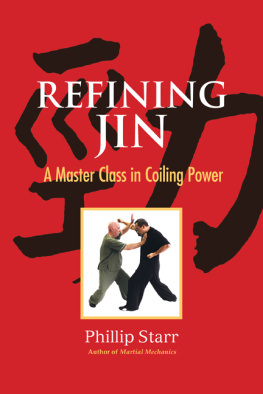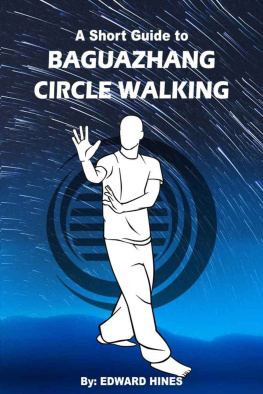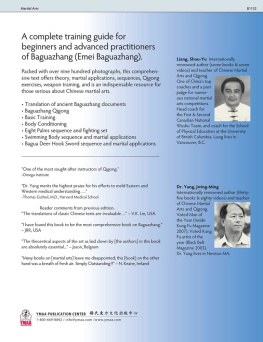Phillip Starr - Baguazhang
Here you can read online Phillip Starr - Baguazhang full text of the book (entire story) in english for free. Download pdf and epub, get meaning, cover and reviews about this ebook. genre: Religion. Description of the work, (preface) as well as reviews are available. Best literature library LitArk.com created for fans of good reading and offers a wide selection of genres:
Romance novel
Science fiction
Adventure
Detective
Science
History
Home and family
Prose
Art
Politics
Computer
Non-fiction
Religion
Business
Children
Humor
Choose a favorite category and find really read worthwhile books. Enjoy immersion in the world of imagination, feel the emotions of the characters or learn something new for yourself, make an fascinating discovery.
- Book:Baguazhang
- Author:
- Genre:
- Rating:4 / 5
- Favourites:Add to favourites
- Your mark:
- 80
- 1
- 2
- 3
- 4
- 5
Baguazhang: summary, description and annotation
We offer to read an annotation, description, summary or preface (depends on what the author of the book "Baguazhang" wrote himself). If you haven't found the necessary information about the book — write in the comments, we will try to find it.
Baguazhang — read online for free the complete book (whole text) full work
Below is the text of the book, divided by pages. System saving the place of the last page read, allows you to conveniently read the book "Baguazhang" online for free, without having to search again every time where you left off. Put a bookmark, and you can go to the page where you finished reading at any time.
Font size:
Interval:
Bookmark:

Copyright 2021 by Phillip Starr. All rights reserved. No portion of this book, except for brief review, may be reproduced, stored in a retrieval system, or transmitted in any form or by any meanselectronic, mechanical, photocopying, recording, or otherwisewithout written permission of the publisher. For information contact Blue Snake Books c/o North Atlantic Books.
Published by Blue Snake Books, an imprint of North Atlantic Books
Berkeley, California
Cover photos by Phillip Starr and Hiro Misawa
Cover design by Jasmine Hromjak
Book design by Happenstance Type-O-Rama
Baguazhang: Fundamentals, Applications, and Footwork is sponsored and published by the Society for the Study of Native Arts and Sciences (dba North Atlantic Books), an educational nonprofit based in Berkeley, California, that collaborates with partners to develop cross-cultural perspectives, nurture holistic views of art, science, the humanities, and healing, and seed personal and global transformation by publishing work on the relationship of body, spirit, and nature.
North Atlantic Books publications are available through most bookstores. For further information, call 800-733-3000 or visit our websites at www.northatlanticbooks.com and www.bluesnakebooks.com.
PLEASE NOTE: The creators and publishers of this book disclaim any liabilities for loss in connection with following any of the practices, exercises, and advice contained herein. To reduce the chance of injury or any other harm, the reader should consult a professional before undertaking this or any other martial arts, movement, meditative arts, health, or exercise program. The instructions and advice printed in this book are not in any way intended as a substitute for medical, mental, or emotional counseling with a licensed physician or healthcare provider.
Library of Congress Cataloging-in-Publication Data
Names: Starr, Phillip, author.
Title: Baguazhang : fundamentals, applications, and footwork / Phillip
Starr.
Description: Berkeley, California : Blue Snake Books, 2021. | Summary: An
introduction to the fundamentals of baguazhang Provided by publisher.
Identifiers: LCCN 2020044162 (print) | LCCN 2020044163 (ebook) | ISBN
9781623175788 (trade paperback) | ISBN 9781623175795 (ebook)
Subjects: LCSH: Hand-to-hand fighting, Oriental. | Self-defense.
Classification: LCC GV1112 .S74 2021 (print) | LCC GV1112 (ebook) | DDC
796.8dc23
LC record available at https://lccn.loc.gov/2020044162
LC ebook record available at https://lccn.loc.gov/2020044163
This book includes recycled material and material from well-managed forests. North Atlantic Books is committed to the protection of our environment. We print on recycled paper whenever possible and partner with printers who strive to use environmentally responsible practices.
For Gussie. Always in my heart.
I owe a debt of thanks to Steiners Martial Arts Academy for allowing me to use their facility for photographs and to Hiro Misawa, Dan Gregory, and Jim OConnell, who kindly assisted with the photography.
B aguazhang is rather young insofar as Chinese martial arts are concerned. Its founder is said to have developed or learned the art (depending on whom you ask) in the earlier part of the nineteenth century. When I was first introduced to this perplexing art in 1965 by my teacher, Master W. C. Chen, it made no sense to me at all. Coming from a shaolinquan and Japanese karate background, I could not imagine how walking in circles and learning to twist and turn my body in different ways could have any practical combative value. And so it was that my teacher demonstrated its effectiveness many times. Asking me to attack him forcefully in any way I wished, he would seemingly vanish and somehow reappear beside me, tapping me (gently, thank God!) on the side or back of my head or body. It seemed easy for him and he elegantly evaded every attack with a smirk on his inscrutable face. It was after several such demonstrations that I determined to learn this strange art as best I could. And so began a lifetime of study and practice, which continues to this day.
This book is an introduction to the fundamentals of baguazhang as I learned it. It is by no means an exhaustive work; such an undertaking would require several volumes! Even so, the material contained between the covers of this book will assist you in building a firm foundation for the development of skill in this unique, abstruse art.
What Is Baguazhang?
B aguazhang, which means Eight Trigrams/Diagrams Palm, is unquestionably one of the most esoteric and misunderstood martial disciplines in existence. Allegedly based upon the eight trigrams (the bagua) of the ancient Book of Changes (the Yijing), baguazhang stresses the importance of maneuverability and change. It emphasizes the application of evasive maneuvers against an aggressors attacks rather than meeting and dealing with them in a head-on fashion. The bagua stylist utilizes various agile and deceptive forms of footwork and body-shifting that enable him or her to seemingly disappear whenever he or she is attacked and then suddenly reappear beside or even behind the opponent.
Trying to strike a bagua boxer is akin to trying to grab the reflection of the moon on the surface of a pond; at the instant you attempt it, the water escapes and immediately surrounds your hand. Your hand gets wet but it comes up empty.
Unlike most martial arts systems that employ a wide and overt array of punches, kicks, and grappling techniques, most of the bodily weapons contained within the baguazhang arsenal are well concealed. Although the movements of this enigmatic art appear to be smooth, flowing, and devoid of any real combative value, the bagua practitioner is capable of instantly emitting uncanny power not only with the hands and feet, but also with several other bodily surfaces, such as the shoulders and hips. Engaging someone who is skilled in this unique art is like jumping feetfirst into a large blender.
Together with taijiquan and xingyiquan, baguazhang is one of the three classical, internal martial arts systems of China, which are generically referred to as the neijia (literally, internal family, also referred to as the three sisters). The term neijia was originally coined in the 1930s by Sun-Lutang, an acknowledged master of all three internal systems.
Exactly why Sun contrived this term in reference to the internal systems is not certain, but the most plausible explanation is that he was trying to emphasize the fact that these particular disciplines emit power by moving from the inside. That is, they stress the importance of moving the body as a single, integrated unit through the implementation of correct body mechanics, breathing, manipulation of small internal muscles, tendons, and other tissues, and the subsequent utilization of intrinsic energy (qi). This is in contrast to the waijia (external or outside family) systems, which often rely largely on the strength of the individual limbs and the overt, larger muscles of the body.
Moreover, the internal systems never oppose force with force because in such an encounter the strongest party will almost always emerge victorious. Instead, they favor yielding and evasive movements that enable them to overcome a stronger force with minimal effort. In many cases, they are able to turn an assailants power back against him. By borrowing the enemys strength, the neijia stylist need not expend much of his own power. This allows him to conserve much of his own energy.
Next pageFont size:
Interval:
Bookmark:
Similar books «Baguazhang»
Look at similar books to Baguazhang. We have selected literature similar in name and meaning in the hope of providing readers with more options to find new, interesting, not yet read works.
Discussion, reviews of the book Baguazhang and just readers' own opinions. Leave your comments, write what you think about the work, its meaning or the main characters. Specify what exactly you liked and what you didn't like, and why you think so.

